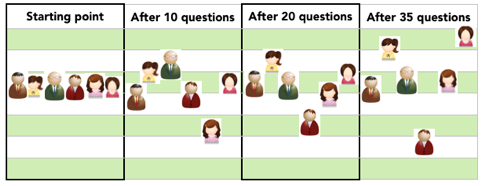After 35 questions are asked the participants find themselves staggered at different points relative to the starting line. Their relative placement providing an insight into their relative disadvantage. I’d recommend you watch the video (http://goo.gl/ydYjzg) or if you’re pressed for time, the diagram gives you a visual description to compliment my description above. Of course, at the end people are surprised by where they end up situated relative to those around them and provide some brief post activity comments as part of the video presentation. If in your working or volunteer life you lead training, I can see how this activity might be a great way to demonstrate privilege and or disadvantage. It’s certainly not predictive as each individual experiences the events identified in the questions uniquely, but it gives a general idea how many factors which are not usually considered contribute to the relative advantage or disadvantage a person experiences. The questions the video makers used are a little USA centric, but very interesting nonetheless. It made me wonder how this exercise might look if we had reliable comparative data which would enable each question to be were weighted (e.g. some questions moved a person two steps or more based on the impact of the issue) and if participants were asked more personal questions (e.g. whether or not they had experienced sexual assault). Certainly if informed with more reliable variables the exercise could be even more revealing, although I can imagine there are quite a few reasons one might not use it as a group training exercise. With my interest piqued I undertook some research and came across a range of reliable Australian sources which discussed personal, structural and community disadvantage. One of the better definitions was published on the Australian Institute of Family Studies. Community disadvantage comes about as a result of the complex interplay between the characteristics of residents living in a community (e.g., unemployment, low income) and the effects of the social and environmental context within the community (e.g., weak social networks, relative lack of opportunities).
Whilst I understand that I’m singing to the choir considering those who usually read my blog, it amazes me how often influential people in politics, public life and the media have not developed any understanding of privilege or disadvantage. Ultimately, this exercise doesn’t have to be scientific. The debrief following the activity is where there is great opportunity for learning and reflection.
0 Comments
Leave a Reply. |
AuthorGeoff has been working in the non-profit sector for twenty years. He maintains a particular interest in organisational culture and values. Archives
February 2018
Categories |
||||||||||


 RSS Feed
RSS Feed
